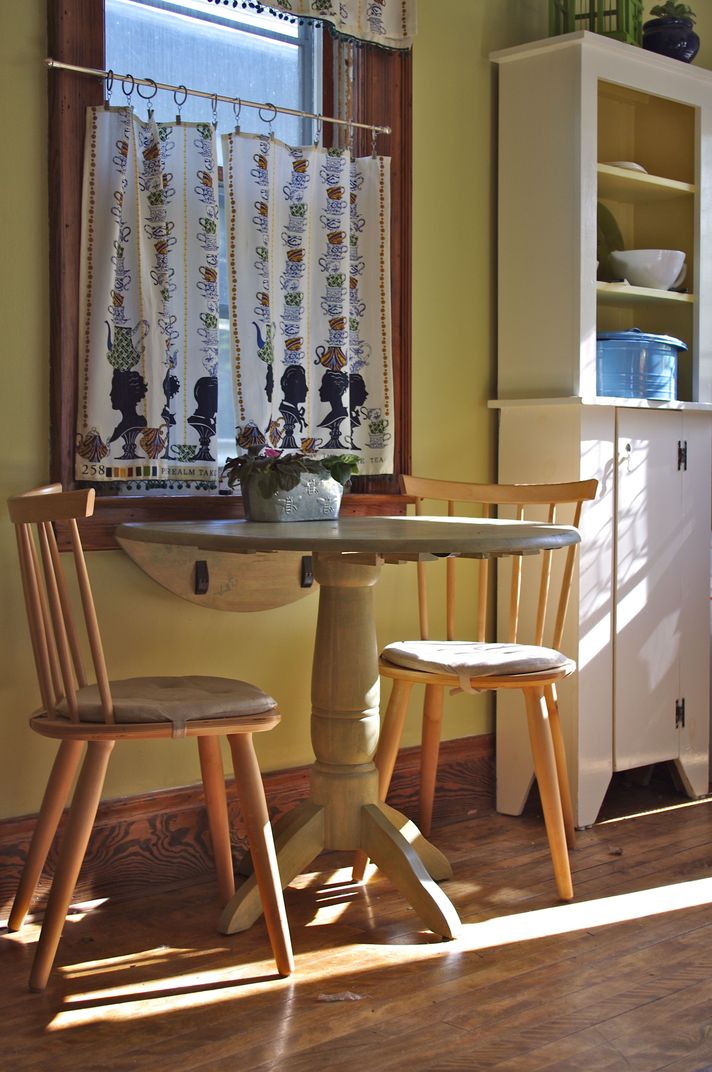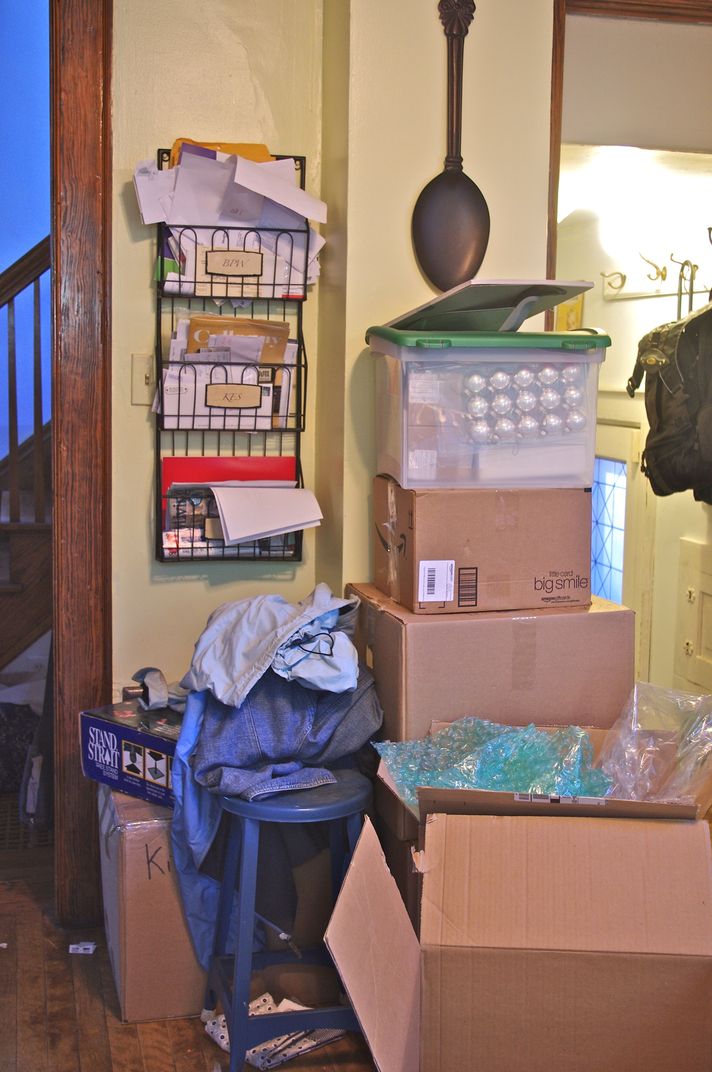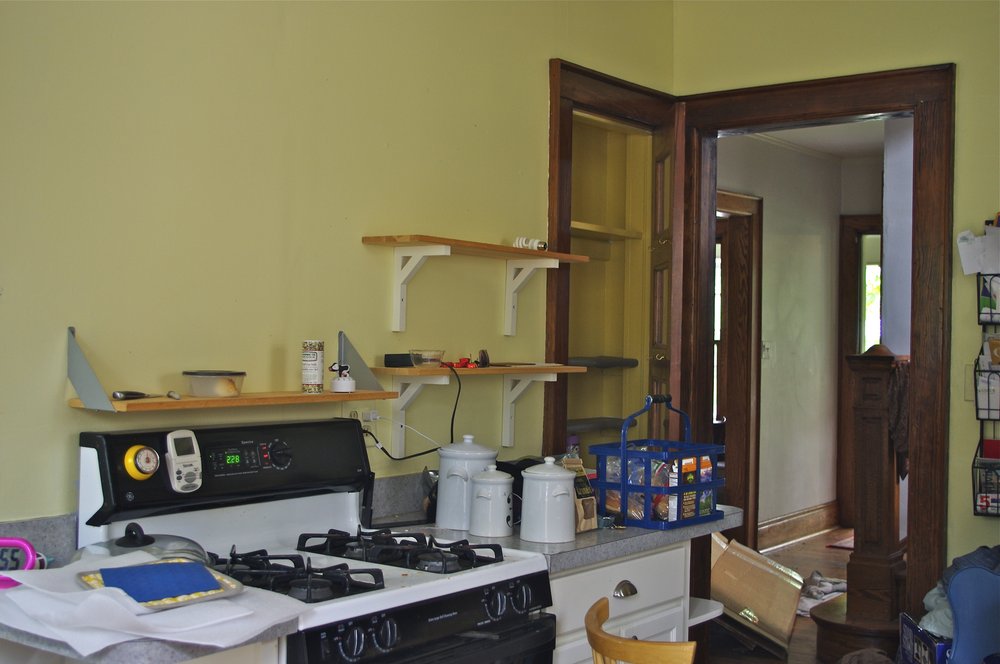Elizabeth is a folklorist, a teacher, a blogger (at www.breadandhoneyblog.com) and a culinary experimenter with a low boredom threshold. She and her partner have recently added a giant puppy to their household; he impedes the experimentation, but she loves him anyway. They used to live in a large, old house with a small, old kitchen in upstate New York — but they are moving out on the day this posts.
Cooking always has an element of the chaotic and the unpredictable — that’s why it’s so compelling. But upon occasion, we have to deal with circumstances that raise the level of chaos past “fun” to “frustrating”. Any manner of things might do this: a renovation, the failure of a major appliance, a toddler or two or three.
Me, I’m moving.
We’ve been very happy in our house in Syracuse, NY but I will admit that this kitchen has always been challenging. It’s shaped like an L, and when the dishwasher is open you can’t get past it to the dining room. The refrigerator is also in the same narrow leg of the L, wedged in next to the wall, so it doesn’t open all the way at the best of times, and not at all if someone is standing at the sink. Every kitchen has its little issues.

But once we started packing, the challenge multiplied. Moreover, we were cooking QUITE A LOT because our goal has been to use up our entire pantry before the move, leaving nothing behind. I thought I’d share the lessons I have learned in this process.
Lesson 1: At the beginning of the process, you can use this time as an opportunity to explore the back of your pantry, unearth forgotten jars, and try those olives, or pickled peppers, or special chocolate. Enjoy this stage. And accept that it won’t last long. Your kitchen is going to get more chaotic as its transition progresses, and soon, you won’t WANT to make sushi. Do it now, or commit to carrying those seaweed sheets and that jar of pickled ginger to storage and back again. All too soon, you will move into the next stage, and then it will be time for my next lesson.
Lesson 2: Don’t set the bar too high. Now is not the time to strive for varied or novel food. Think flexible, comforting, and high-protein to sustain you through this stressful time. I’ve been focused on using up the ingredients I have on hand, not on creating perfectly balanced, healthful meals. Anything you make at home will be healthier than resorting to take-out, so don’t sweat it.
Lesson 3: Your slow cooker is your friend. Really. You may think that you should pack up nonessential appliances, and by all means, put the toaster away and pack the mixer (and then tell me how to pack the mixer). But leave the slow cooker out. You can set it anywhere in the house, and it will make dinner for you when you’re too busy. Chili is easy and tasty; so is bolognese sauce; both of them are good ways to use up random bits. Frozen hamburger patties? Two sausages? Leftover turkey? A half a bunch of carrots? Put it all in. It’s out of your refrigerator and gone!
Lesson 4: Don’t buy any more produce. No, really. No matter how tempting it looks. No matter how much you want a salad. Produce takes up space both to keep, and to prepare. Do you know what I have on my counters right now, as I type? When I look around I see a basket of bread, three canisters of dog treats, the KitchenAid mixer that defies my attempts to pack it, two plastic baskets, a napkin holder, three small cardboard boxes, three empty glass storage jars, a bag of rice, a banana and its cloud of victorious fruit flies, two cell phone chargers, and three wrenches hiding under a potholder. Nothing edible (especially that banana) and no room to wash, stem and chop it.
Now, I have friends who will kick at Lesson 4 (I’m looking at you, Linda) but refer back to Lesson 2, and trust me. It won’t hurt you to go without fresh vegetables for a week or two. It will make you sad, especially in June, but it won’t hurt you. Use up what’s in your freezer first.
Lesson 5: If you have enough of anything to make a big batch of something, invite your friends over to help you eat it. That will get rid of a lot of food, and if they’re very nice friends, they’ll help you pack, too — mine did. All I fed them was soup: the penultimate onion, the last of my stock of homemade stock, half a bag of frozen vegetables, the final handful of spinach, some tortellini and some cartwheel pasta, some shredded turkey breast that’s been frozen since Christmas, and the last two cubes of last summer’s pesto (all of it — gone!). Almost every single thing helped empty my freezer, and all I had to do was simmer it up. (My friends brought dessert. Did I mention yet that I have great friends?)
Lesson 6: Oh, for goodness’ sake, throw that away. If you’re renovating, it might be worth storing things in the basement for a while. But if you’re moving, none of your pantry staples will be improved by three days in a moving truck. The last inch of sesame oil? Two teaspoons of poppy seeds? Toss them. I know it’s hard. Do it.

Lesson 7: Multi-task. Not you — well, yes you — but especially your food. A couple of nights ago I decided to attack the last three raw chicken breasts. I trimmed them all, poached two for tomorrow’s chicken salad, and cut the third into medallions. I made a not-quite-cacciatore sauce (gone: the last of last summer’s roasted tomatoes), and served it over mushroom ravioli (gone!). The other two breasts solved the lunch conundrum for a couple of days. Multi-tasking took all the pans I had left unpacked, and that brings me to the corollary for Lesson 6: although I just told you to pack all the appliances except the slow cooker, when it’s time to pack the pans, leave yourself at least two skillets, a medium stockpot, and one small saucepan. Give yourself enough cookware to multi-task with. And leave out the BIG skillet. You can fry a lonely egg in it. You can’t make dinner for four in the little one.
Lesson 8: If it’s been sitting the freezer for eight months because you didn’t know what to do with it, chances are that genius will not strike now. Free yourself from the shackles of ingredients you perhaps shouldn’t have bought in the first place, or just let go of things you meant-to-make. Curry is my no-fail dish for food I don’t know what to do with, so last night I made a curry out of a cup and a half of white pumpkin (frozen since Halloween — now gone!), chickpeas and fava beans (gone!), half a bag of my emergency frozen vegetables, biryani spice paste, a sad red onion, and some garlic struggling for freedom on the kitchen windowsill. Does that sound appetizing? I didn’t think so. And it wasn’t. It MAY have been the worst meal I’ve made since we moved into this house. The pumpkin separated into fibers and water instead of lush puree, the beans were too firm despite a day in the slow cooker, and the dish had heat but no flavor. Which leads me to…
Lesson 9: Don’t punish yourself. You might get to the crackers and peanut butter stage, but until the cupboard is gloriously bare, there’s no reason to exacerbate an already stressful time by suffering through your meals. Hate lima beans? Keeping them out of a sense of duty? Throw them out and whip up some pancakes. That curry of mine? I tipped it in the bin.
The truth is that most likely, you’re not going to make that “cook everything up” goal. Sorry, but there it is. Do your best and don’t punish yourself when you fall short. If you’re renovating, you might have a chest freezer you can store things in. Or a friend who will dedicate a shelf to you. If you’re moving across town, you might be able to move food — if the food is worth the effort. If you’re moving to another state, like me, you should accept your limitations. I’ve fed friends; I’ve ravaged my roasted tomato stockpile; I’ve given away boxes of food; I’ve rigorously discarded old and almost-used-up condiments. But the time of hard decisions is upon me now, and it will come to you in your turn. You’ll have to decide how to handle it yourself, but please refer back to Lesson 8. Do you really need to carry a can of black beans to Pennsylvania? No, you don’t. And your local Food Pantry could use it.

Lesson 10: Let your friends feed you. Your friends are probably excellent cooks (mine are). They are probably nice people, or you wouldn’t be friends with them. My friends are feeding us twice a day for the last three days before we move. I am cheerfully tossing the last of my dried beans and pasta in the kitchen bin. Someone is bringing me a gin and tonic at 8:00 tonight. I love my friends.